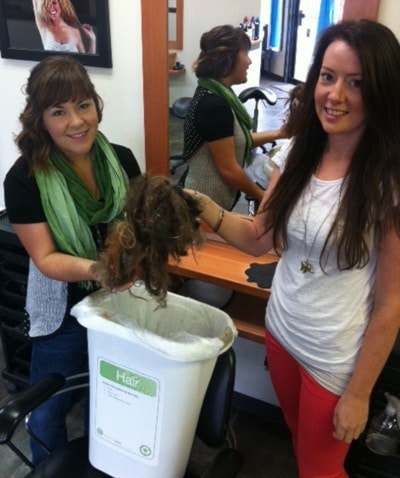Hair today, oil block tomorrow
Who would think getting your hair cut could halt an oil spill? Now it can, thanks to a handful of Island salons who are rallying together to put all those clippings to good use.
With increasing concerns of the Enbridge Northern Gateway Pipeline Project, 12 Victoria and five Nanaimo salons have started gathering snipped hair — the most effective material to create hair booms and hair mats on shorelines for oil cleanup — in the case of an oil spill on the West Coast. Many of the same salons donated hair to clean up the Gulf Coast BP oil spill in 2010, and recognize that the hair grown right here on the West Coast can be put to use close to home in the event of a spill. Green Circle Salons has offered to store the hair in Burnaby, and will hand over the stockpile in the event of a spill.
Human hair behaves much like the fur and feathers seen on oil-covered wildlife after a spill — it absorbs and clings to oil. “Until now, our industry’s waste has gone to landfills because it’s not like typical commercial or office waste,” says Jennifer Hennessey with Green Circle Salons. “We are diverting, literally, football fields full of waste each month.”
Green Circle has been collecting hair from Ontario salons for over three years, but has just launched its operations in Metro Vancouver, Victoria and Nanaimo. “We can do this, one salon at a time,” says Hennessey. “We encourage each and every customer to ask their salon to become a Green Circle Salon member. Not only do we re-purpose the hair for oil spill cleanup, but we also pick up their foils, colour tubes and excess chemicals that would have otherwise gone into landfills or down the drain. These chemicals simply don’t belong in our waterways.”
Participating Victoria salons include Aveda Institute, Carreiro the Studio, DesignHouse Salon, Gemi/ Phoenica Styles, Hive Hair, Kazen Hair & Beauty, Lab Salon, Luv Salon, On the Fringe, Parlour Salon, The Gallery, Wiink2 for Hair & Body. See GreenCircleSalons.ca for an updated list.
Funds to ease the pain
With news of the death of a 13-year-old Sooke boy who was hit by a pickup truck on Sooke Road last week, the surrounding community has heaved together to offer the only condolence it really can: fundraising for a grief-stricken single mother who can’t yet return to work, but has three other children to care for, along with looming bills and rent to pay.
Troy Thompson, 31, was one of the first on the scene when AJ (Adam Jessie) Wakeling stepped off a bus with his twin brother, then crossed a street and was hit by a motorist. Thompson’s role quickly unfolded as support for Wakeling’s mother, Yannick Aubin, who remained in shock at the scene.
“You feel helpless, because there is nothing you can say to someone in that situation — what can you say? — but I did my best to pick her up off the pavement and just be there,” says Thompson.
In an effort to do more, Thompson has started the Facebook page “Fund raising for AJ Wakeling,” which directs members to the online community-created fundraising page fundrazr.com/campaigns/bNVE4. So far, Thompson’s page has gained 729 members in only a few days. More than $2,000 has been raised for the family.
Cheap drink the best kind— By Colin Cayer
Try to withhold your gasps: people are less likely to buy high-alcohol drinks if they are more expensive.
Research by UVic’s Centre for Addictions Research of BC (CARBC) and the Centre for Addictions and Mental Health (CAMH) in Toronto shows that people still pick saving money over getting drunk. The two groups followed sales data in Saskatchewan before and after a price-hike implementation. A 10 per cent increase in price resulted in a 22 per cent decrease in sales for high alcohol (6.5 per cent and up) beer. Coolers and cocktails also saw large reductions in sales, at 13.2 per cent and 21.3 per cent respectively.
Funny enough, Alberta showed no change in per-capita alcohol consumption before and after the increase was implemented.
Dr. Tim Stockwell, CARBC’s director and lead author of the report, says it’s quite easy for provinces to implement these kinds of policies because of government monopoly arrangements.
“Saskatchewan’s new approach is right up there as one of the best. Their approach applies to all beverages, including spirits,” Stockwell says. “In B.C., minimum prices of spirits are the only ones that get adjusted with any regularity, so there’s been a shift towards cheaper beer, coolers and wine.”
While price increases may be deterrents (in some locations), it does not reflect the social factors that lead to alcohol abuse, apart from a cursory connection to low-income populations. The implications of the study are geared toward policy makers, although riskier consumers, heavy and young drinkers, are cited as more inclined to purchase cheap alcohol.
Read the report at: http://bit.ly/RMQwW6. M
